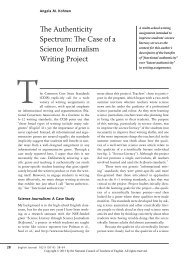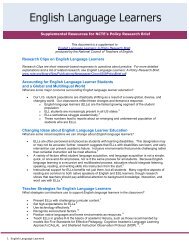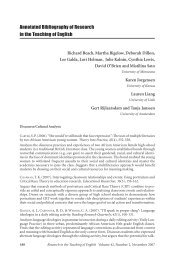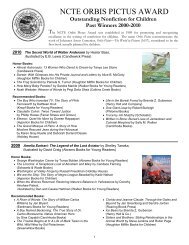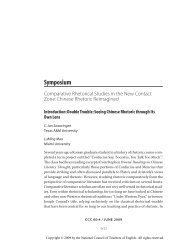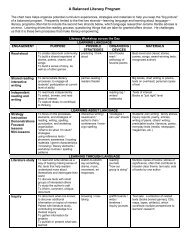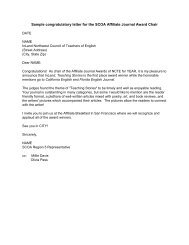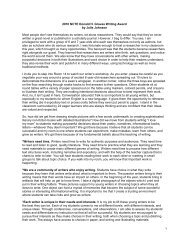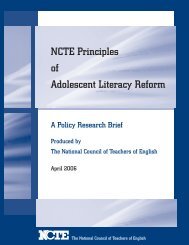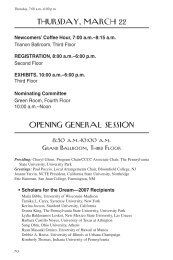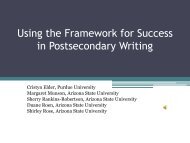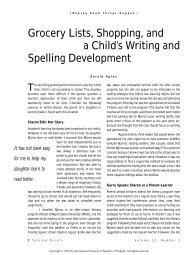Annotated Bibliography of Research in the Teaching of English
Annotated Bibliography of Research in the Teaching of English
Annotated Bibliography of Research in the Teaching of English
- No tags were found...
You also want an ePaper? Increase the reach of your titles
YUMPU automatically turns print PDFs into web optimized ePapers that Google loves.
<strong>Annotated</strong> <strong>Bibliography</strong> 231DAVISON, C., & CUMMINS, J. (EDS.). (2006). International handbook <strong>of</strong> <strong>English</strong> language teach<strong>in</strong>g.New York: Spr<strong>in</strong>ger.FARR, M. (ED.). (2005). Lat<strong>in</strong>o language and literacy <strong>in</strong> ethnol<strong>in</strong>guistic Chicago. Mahwah, NJ:Erlbaum.HALL, J. K., VITANOVA, G., & MARCHENKOVA, L. (EDS.). (2005). Dialogue with Bakht<strong>in</strong> on second andforeign language learn<strong>in</strong>g: New perspectives. Mahwah, NJ: Erlbaum.HANEDA, M. (2005). Invest<strong>in</strong>g <strong>in</strong> foreign-language writ<strong>in</strong>g: A study <strong>of</strong> two multicultural learners.Journal <strong>of</strong> Language, Identity & Education, 4(4), 269-290.HUA, Z., & DODD, B. (EDS.). (2006). Phonological development and disorders <strong>in</strong> children: A multil<strong>in</strong>gualperspective. Buffalo, NY: Multil<strong>in</strong>gual Matters.JOHNSON, E. (2005). Proposition 203: A critical metaphor analysis. Bil<strong>in</strong>gual <strong>Research</strong> Journal,29(1), 69-84.JORDA, M. P. S. (2005). Third language learners: Pragmatic production and awareness. Buffalo, NY:Multil<strong>in</strong>gual Matters.KASPER, L. F., & WEISS, S. T. (2005). Build<strong>in</strong>g ESL student l<strong>in</strong>guistic and academic literacy throughcontent-based <strong>in</strong>terclass collaboration. Teach<strong>in</strong>g <strong>English</strong> <strong>in</strong> <strong>the</strong> Two Year College, 32(2), 282-297.KERN, R., & SCHULTZ, J. M. (2005). Beyond orality: Investigat<strong>in</strong>g literacy and <strong>the</strong> literary <strong>in</strong> secondand foreign language <strong>in</strong>struction. The Modern Language Journal, 89(3), 381-392.KING, K., & GANUZA, N. (2005). Language, identity, education, and transmigration: Chilean adolescents<strong>in</strong> Sweden. Journal <strong>of</strong> Language Identity and Education, 4(3), 179-199.KONDO-BROWN, K. (2006). How do <strong>English</strong> L1 learners <strong>of</strong> advanced Japanese <strong>in</strong>fer unknownKanji worlds <strong>in</strong> au<strong>the</strong>ntic texts? Language Learn<strong>in</strong>g, 56(1), 109-153.LAIJA-RODRÍGUEZ, W., OCHOA, S. H., & PARKER, R. (2006). The crossl<strong>in</strong>guistic role <strong>of</strong> cognitiveacademic language pr<strong>of</strong>iciency on read<strong>in</strong>g growth <strong>in</strong> <strong>English</strong> and Spanish. Bil<strong>in</strong>gual <strong>Research</strong>Journal, 30(1), 87-106.LANTOLF, J. P. (2006). Sociocultural <strong>the</strong>ory and <strong>the</strong> genesis <strong>of</strong> second language development. Oxford,UK: Oxford University Press.LIANG, X. (2006). Identity and language functions: High school Ch<strong>in</strong>ese immigrant students’code-switch<strong>in</strong>g dilemmas <strong>in</strong> ESL classes. Journal <strong>of</strong> Language, Identity & Education, 5(2), 143-167.MCBRIDE-CHANG, C., & SUK-HAN HO, C. (2005). Predictors <strong>of</strong> beg<strong>in</strong>n<strong>in</strong>g read<strong>in</strong>g <strong>in</strong> Ch<strong>in</strong>ese and<strong>English</strong>: A 2-year longitud<strong>in</strong>al study <strong>of</strong> Ch<strong>in</strong>ese k<strong>in</strong>dergarteners. Scientific Studies <strong>of</strong> Read<strong>in</strong>g,9(2), 117-144.PICHETTE, F. (2005). Time spent on read<strong>in</strong>g and read<strong>in</strong>g comprehension <strong>in</strong> second languagelearn<strong>in</strong>g. Canadian Modern Language Review, 62(2), 243-262.REESE, L., & GOLDENBERG, C. (2006). Community contexts for literacy development <strong>of</strong> Lat<strong>in</strong>a/ochildren: Contrast<strong>in</strong>g case studies. Anthropology & Education Quarterly, 37(1), 42-61.ROCA DE LARIOS, J., MANCHON, R. M., & MURPHY, L. (2006). Generat<strong>in</strong>g text <strong>in</strong> native and foreignlanguage writ<strong>in</strong>g: A temporal analysis <strong>of</strong> problem-solv<strong>in</strong>g formulation processes. The ModernLanguage Journal, 90(1), 100-114.ROBERTS, T. A. (2005). Articulation accuracy and vocabulary size contributions to phonemicawareness and word read<strong>in</strong>g <strong>in</strong> <strong>English</strong> language learners. Journal <strong>of</strong> Educational Psychology,97(4), 601-616.SANZ, C. (2005). M<strong>in</strong>d and context <strong>in</strong> adult second language acquisition: Methods, <strong>the</strong>ory, andpractice. Wash<strong>in</strong>gton, DC: Georgetown University Press.SHEOREY, R. (2006). Learn<strong>in</strong>g and teach<strong>in</strong>g <strong>English</strong> <strong>in</strong> India. Thousand Oaks, CA: Sage.STAKHNEVICH, J. (2005). Third language acquisition <strong>in</strong> immersion: A case study <strong>of</strong> a bil<strong>in</strong>gualimmigrant learner. Critical Inquiry <strong>in</strong> Language Studies, 2(4), 215-232.



